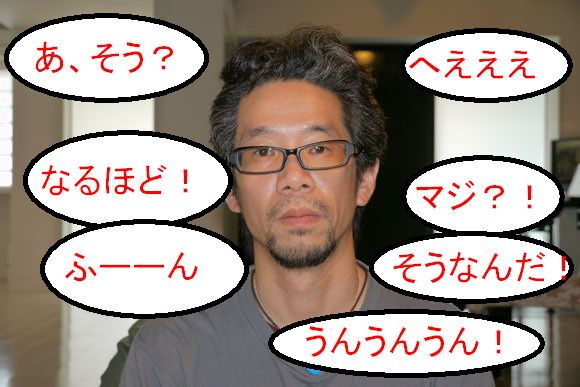
Chances are, if you’ve ever had a conversation in Japanese – or even any other language – with a native Japanese person, you might have been slightly disconcerted by their constant interjections.
That’s because nodding along, saying things like “I see” (naruhodo), “Oh really?” (sou desu ka?) and just plain grunting is considered a polite way to indicate to a speaker that you’re following along in a conversation.
This technique is called “aizuchi” in Japanese and, sure, it seems common sense in any culture to occasionally give a nod of the head or look up from your riveting game of Candy Crush Saga to indicate you have at least a passing interest in what’s being said, but the Japanese really turn it into an art form.
We’ll let YouTuber and Japan resident Micaela give you a sample of what it sounds and feels like below and then give our thoughts on this uniquely Japanese phenomena:
Micaela is generally absolutely right in that aizuchi can seem a little annoying to foreigners who aren’t used to it, but in reality, it isn’t, strictly speaking, always used to show a listener you’re following along. Like in other cultures, depending on tone and body language, aizuchi can also be used to indicate you want the speaker to get to the point or just wrap it up with the whole talking thing.
So, when a Japanese person says, “aa, sou?” , he/she could be indicating that they’re interested in what you’re saying, but it could also be a polite way of telling you, “Hey, I’m sure whatever you’re saying is very interesting, but right now I’m a little more interested in this delicious meatball sub, so could you come back later?”
“This is very important.”
Micaela’s point about conversations in Japanese tending to revolve around the listener’s obsession with your foreignness is also something that longtime foreign Japan residents can probably identify with. Just imagine if a foreigner’s idea of aizuchi was to interrupt dialogue with a Japanese speaker by shouting, “WOW! You can eat meatball subs? That is SOOO impressive!” (Sorry, I… have a lot of conversations about meatball subs.)
The indisputable deliciousness of meatball subs notwithstanding, if you’re learning Japanese, getting used to both hearing aizuchi and using them yourself is a great and pretty easy way to make your Japanese sound more natural and cut down on misunderstandings.
And, because we love you, here are a few suggestions (along with rough translations, but you’re better off learning how to use them by mimicking those around you) for great borderline-grunting sounds you can use to customize your aizuchi. Say them with an upward intonation to indicate intense interest, or in a flat monotone and with a blank, uninterested expression if you just want the speaker to shut up:
“eeeeeeeeh!” (“Whaaaat?”/”No way!”)
“Sou nan da!” (“Oh, that’s right!”/”Right, I get it!”)
“Naruhodo ne” (“Ah, so that’s how it is.”/”Right, I see.”)
“nnnnnnnn” (A deep and meaningful “I’m considering what you’re saying.”)
“fuuuuuuun” (“I’m listening, and it’s intriguing!”)
“Un un un!” (“Right, right right!”)
“KRAKAW! KRAKAW!” (Said while flapping your arms up and down like bird wings.)
We hope you find these useful, Japanese learners! And, be sure to upload your conversation to YouTube for us if you choose to use that last one.
Source: Kotaro Blog
Feature photo: RocketNews24
Inset: Croquille Master


 Seven mistakes foreigners make when speaking Japanese—and how to fix them
Seven mistakes foreigners make when speaking Japanese—and how to fix them Japanese convenience store apologizes for putting Meatballs in meatball packages, issues recall
Japanese convenience store apologizes for putting Meatballs in meatball packages, issues recall No good at saving money? You may have your mother tongue to blame for that
No good at saving money? You may have your mother tongue to blame for that We visited Tokyo’s Frozen II collab cafe and may have enjoyed it more than the movie 【Photos】
We visited Tokyo’s Frozen II collab cafe and may have enjoyed it more than the movie 【Photos】 “Akakara Cochin meatball pizza” is the latest collaboration pizza in Japan, actually looks pretty good!
“Akakara Cochin meatball pizza” is the latest collaboration pizza in Japan, actually looks pretty good! Foreigner’s request for help in Tokyo makes us sad for the state of society
Foreigner’s request for help in Tokyo makes us sad for the state of society Japanese city loses residents’ personal data, which was on paper being transported on a windy day
Japanese city loses residents’ personal data, which was on paper being transported on a windy day Akihabara pop-up shop sells goods made by Japanese prison inmates
Akihabara pop-up shop sells goods made by Japanese prison inmates Ghibli Park now selling “Grilled Frogs” from food cart in Valley of Witches
Ghibli Park now selling “Grilled Frogs” from food cart in Valley of Witches Historical figures get manga makeovers from artists of Spy x Family, My Hero Academia and more
Historical figures get manga makeovers from artists of Spy x Family, My Hero Academia and more Tokyo Tsukiji fish market site to be redeveloped with 50,000-seat stadium, hotel, shopping center
Tokyo Tsukiji fish market site to be redeveloped with 50,000-seat stadium, hotel, shopping center Beautiful Ghibli sealing wax kits let you create accessories and elegant letter decorations【Pics】
Beautiful Ghibli sealing wax kits let you create accessories and elegant letter decorations【Pics】 Harajuku Station’s beautiful old wooden building is set to return, with a new complex around it
Harajuku Station’s beautiful old wooden building is set to return, with a new complex around it Anime girl English teacher Ellen-sensei becomes VTuber/VVTUber and NFT
Anime girl English teacher Ellen-sensei becomes VTuber/VVTUber and NFT We tried Korea’s way-too-big King Tonkatsu Burger at Lotteria 【Taste Test】
We tried Korea’s way-too-big King Tonkatsu Burger at Lotteria 【Taste Test】 McDonald’s new Happy Meals offer up cute and practical Sanrio lifestyle goods
McDonald’s new Happy Meals offer up cute and practical Sanrio lifestyle goods Japanese ramen restaurants under pressure from new yen banknotes
Japanese ramen restaurants under pressure from new yen banknotes French Fries Bread in Tokyo’s Shibuya becomes a hit on social media
French Fries Bread in Tokyo’s Shibuya becomes a hit on social media Studio Ghibli releases new action figures featuring Nausicaä of the Valley of the Wind characters
Studio Ghibli releases new action figures featuring Nausicaä of the Valley of the Wind characters New private rooms on Tokaido Shinkansen change the way we travel from Tokyo to Kyoto
New private rooms on Tokaido Shinkansen change the way we travel from Tokyo to Kyoto Red light district sushi restaurant in Tokyo shows us just how wrong we were about it
Red light district sushi restaurant in Tokyo shows us just how wrong we were about it All-you-can-drink Starbucks and amazing views part of Tokyo’s new 170 meter-high sky lounge
All-you-can-drink Starbucks and amazing views part of Tokyo’s new 170 meter-high sky lounge Studio Ghibli releases Kiki’s Delivery Service chocolate cake pouches in Japan
Studio Ghibli releases Kiki’s Delivery Service chocolate cake pouches in Japan New definition of “Japanese whiskey” goes into effect to prevent fakes from fooling overseas buyers
New definition of “Japanese whiskey” goes into effect to prevent fakes from fooling overseas buyers Our Japanese reporter visits Costco in the U.S., finds super American and very Japanese things
Our Japanese reporter visits Costco in the U.S., finds super American and very Japanese things Studio Ghibli unveils Mother’s Day gift set that captures the love in My Neighbour Totoro
Studio Ghibli unveils Mother’s Day gift set that captures the love in My Neighbour Totoro More foreign tourists than ever before in history visited Japan last month
More foreign tourists than ever before in history visited Japan last month New Pokémon cakes let you eat your way through Pikachu and all the Eevee evolutions
New Pokémon cakes let you eat your way through Pikachu and all the Eevee evolutions Sales of Japan’s most convenient train ticket/shopping payment cards suspended indefinitely
Sales of Japan’s most convenient train ticket/shopping payment cards suspended indefinitely Sold-out Studio Ghibli desktop humidifiers are back so Totoro can help you through the dry season
Sold-out Studio Ghibli desktop humidifiers are back so Totoro can help you through the dry season Japanese government to make first change to romanization spelling rules since the 1950s
Japanese government to make first change to romanization spelling rules since the 1950s Ghibli founders Toshio Suzuki and Hayao Miyazaki contribute to Japanese whisky Totoro label design
Ghibli founders Toshio Suzuki and Hayao Miyazaki contribute to Japanese whisky Totoro label design Doraemon found buried at sea as scene from 1993 anime becomes real life【Photos】
Doraemon found buried at sea as scene from 1993 anime becomes real life【Photos】 Tokyo’s most famous Starbucks is closed
Tokyo’s most famous Starbucks is closed One Piece characters’ nationalities revealed, but fans have mixed opinions
One Piece characters’ nationalities revealed, but fans have mixed opinions We asked a Uniqlo employee what four things we should buy and their suggestions didn’t disappoint
We asked a Uniqlo employee what four things we should buy and their suggestions didn’t disappoint Princesses, fruits, and blacksmiths: Study reveals the 30 most unusual family names in Japan
Princesses, fruits, and blacksmiths: Study reveals the 30 most unusual family names in Japan RocketNews24’s six top tips for learning Japanese
RocketNews24’s six top tips for learning Japanese Japanese elementary school student teaches us all how to pronounce English like a native speaker
Japanese elementary school student teaches us all how to pronounce English like a native speaker New list of inappropriate Japanese job interview questions from prefectural labor department
New list of inappropriate Japanese job interview questions from prefectural labor department Pokémon Cafe releases limited-time Pokémon Starter menu ahead of Sword and Shield release
Pokémon Cafe releases limited-time Pokémon Starter menu ahead of Sword and Shield release “Boyfriend hug” speakers are the perfect way to look absolutely normal in public【Video】
“Boyfriend hug” speakers are the perfect way to look absolutely normal in public【Video】 English conversation school in Japan has clever reminder that students don’t have to be perfect
English conversation school in Japan has clever reminder that students don’t have to be perfect Canadian YouTuber explains why she quit working on Japanese TV
Canadian YouTuber explains why she quit working on Japanese TV Mr. Sato warms an egg in his armpit for a delicious Japanese dish【SoraKitchen】
Mr. Sato warms an egg in his armpit for a delicious Japanese dish【SoraKitchen】 Five reasons not to live in Japan (as chosen by Switzerland’s perviest otaku)
Five reasons not to live in Japan (as chosen by Switzerland’s perviest otaku) Westerners in Japan – do they really ALL speak English? 【Video】
Westerners in Japan – do they really ALL speak English? 【Video】 Seriously? Olive oil!? Turn ice cream into gourmet gelato with this easy but fattening trick
Seriously? Olive oil!? Turn ice cream into gourmet gelato with this easy but fattening trick We visit the limited-time IKEA café in Tokyo
We visit the limited-time IKEA café in Tokyo Limited-time Tom and Jerry cafés are now open in Tokyo and Shinjuku to serve up cartoony cuisine
Limited-time Tom and Jerry cafés are now open in Tokyo and Shinjuku to serve up cartoony cuisine A six-year-old smashed the previous limbo skating record, in case you wanted to know
A six-year-old smashed the previous limbo skating record, in case you wanted to know Here’s how manga hit One Piece is like sex, politics, and religion
Here’s how manga hit One Piece is like sex, politics, and religion
Leave a Reply